NSB102 Assignment 2: Dementia Health Issue Analysis - Australia
VerifiedAdded on 2022/10/19
|11
|3352
|13
Essay
AI Summary
This essay provides an analysis of the dementia health issue in Australia, examining various aspects of the issue. It begins by highlighting the prevalence of dementia, particularly among the elderly population, and notes the higher incidence among women and Aboriginal populations in rural areas. The essay discusses the types of healthcare delivery utilized, including primary care, community services, palliative care, and institutional care, while also exploring the values underpinning these approaches. It emphasizes the importance of early intervention and the challenges faced in providing equitable care, especially in diverse communities. Furthermore, the essay identifies poverty as a key social determinant, highlighting its impact on access to healthcare and overall health outcomes. The essay then addresses the significance of cultural safety and person-centered care, emphasizing the need to address discrimination and implement ethical codes to improve care for individuals with dementia.
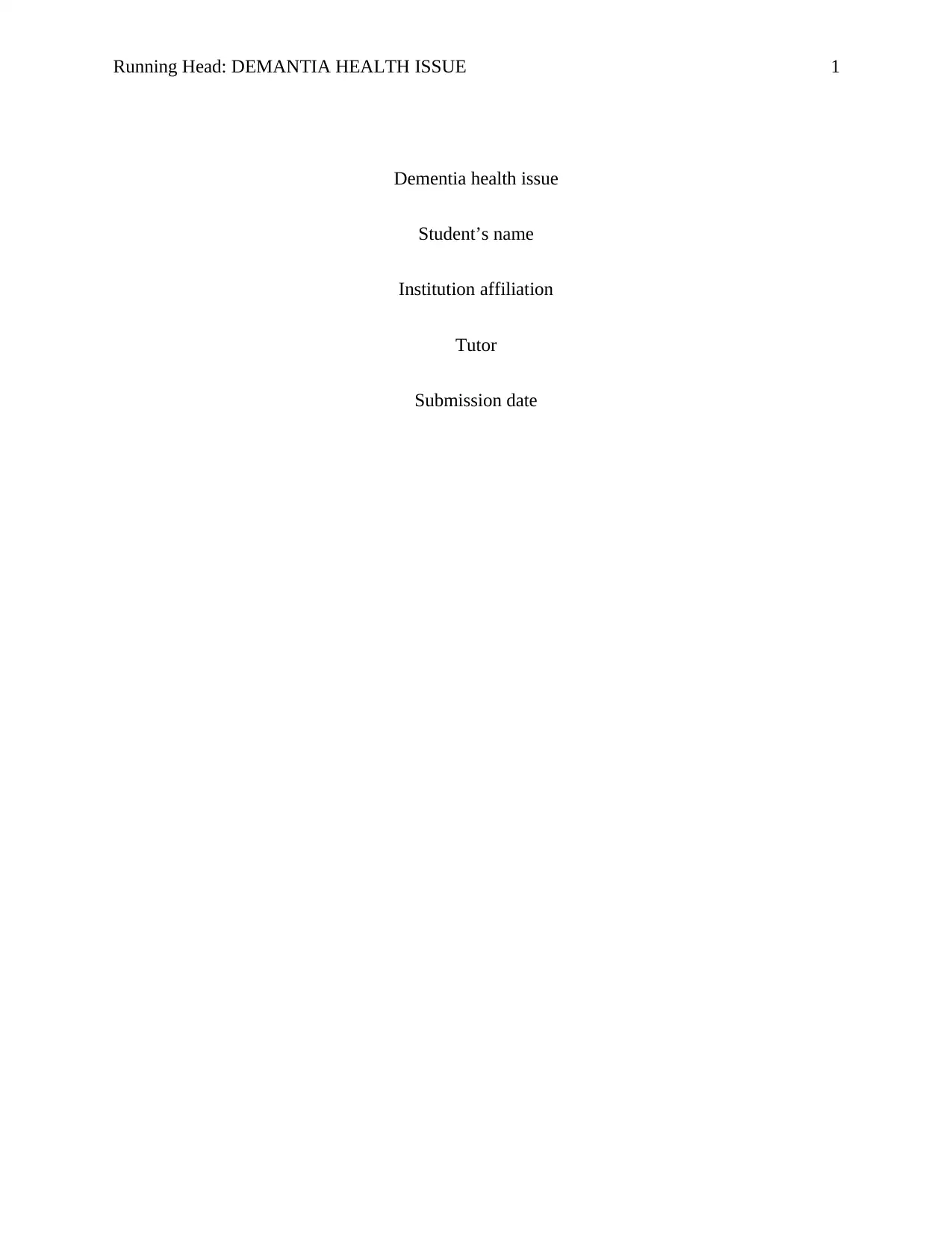
Running Head: DEMANTIA HEALTH ISSUE 1
Dementia health issue
Student’s name
Institution affiliation
Tutor
Submission date
Dementia health issue
Student’s name
Institution affiliation
Tutor
Submission date
Paraphrase This Document
Need a fresh take? Get an instant paraphrase of this document with our AI Paraphraser
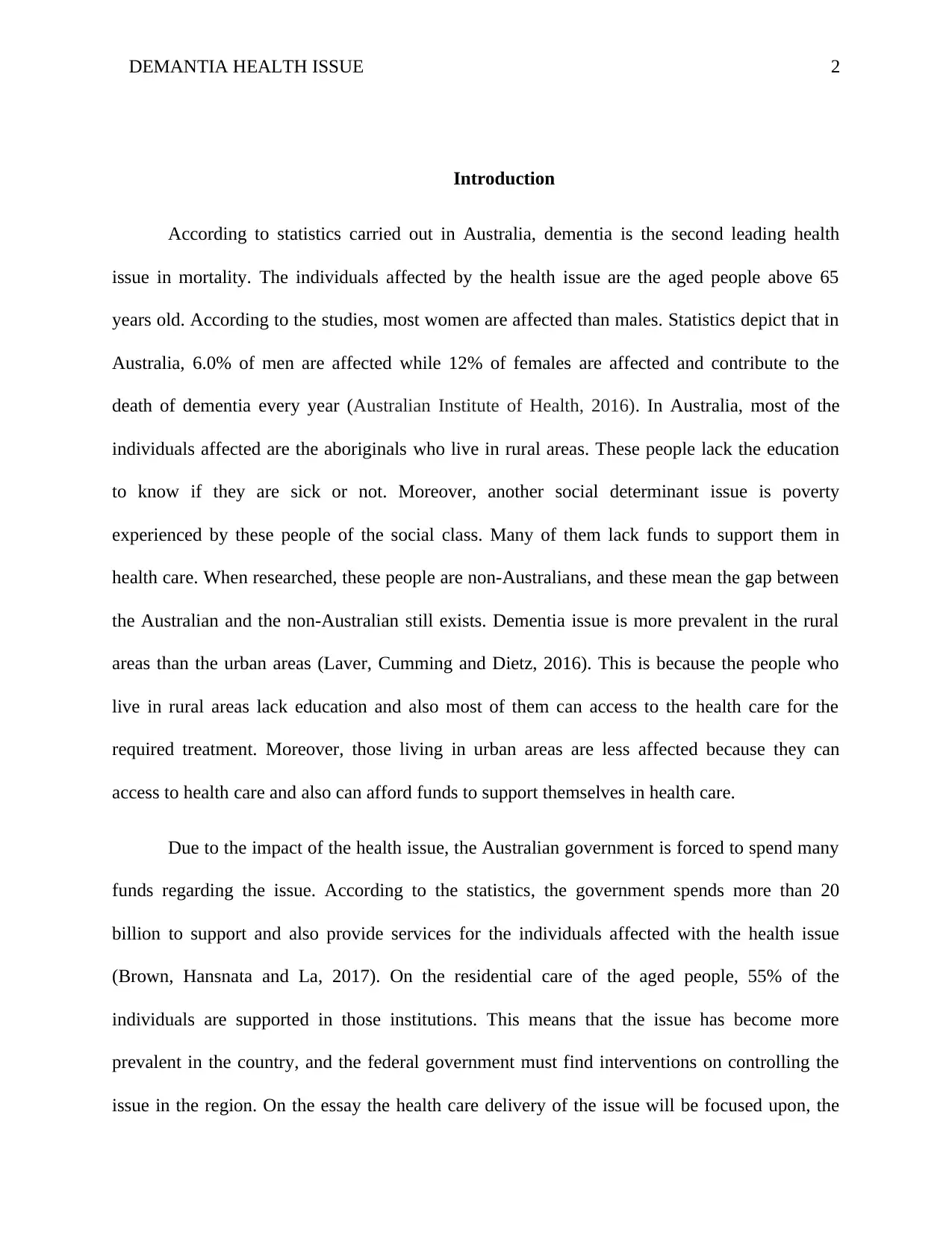
DEMANTIA HEALTH ISSUE 2
Introduction
According to statistics carried out in Australia, dementia is the second leading health
issue in mortality. The individuals affected by the health issue are the aged people above 65
years old. According to the studies, most women are affected than males. Statistics depict that in
Australia, 6.0% of men are affected while 12% of females are affected and contribute to the
death of dementia every year (Australian Institute of Health, 2016). In Australia, most of the
individuals affected are the aboriginals who live in rural areas. These people lack the education
to know if they are sick or not. Moreover, another social determinant issue is poverty
experienced by these people of the social class. Many of them lack funds to support them in
health care. When researched, these people are non-Australians, and these mean the gap between
the Australian and the non-Australian still exists. Dementia issue is more prevalent in the rural
areas than the urban areas (Laver, Cumming and Dietz, 2016). This is because the people who
live in rural areas lack education and also most of them can access to the health care for the
required treatment. Moreover, those living in urban areas are less affected because they can
access to health care and also can afford funds to support themselves in health care.
Due to the impact of the health issue, the Australian government is forced to spend many
funds regarding the issue. According to the statistics, the government spends more than 20
billion to support and also provide services for the individuals affected with the health issue
(Brown, Hansnata and La, 2017). On the residential care of the aged people, 55% of the
individuals are supported in those institutions. This means that the issue has become more
prevalent in the country, and the federal government must find interventions on controlling the
issue in the region. On the essay the health care delivery of the issue will be focused upon, the
Introduction
According to statistics carried out in Australia, dementia is the second leading health
issue in mortality. The individuals affected by the health issue are the aged people above 65
years old. According to the studies, most women are affected than males. Statistics depict that in
Australia, 6.0% of men are affected while 12% of females are affected and contribute to the
death of dementia every year (Australian Institute of Health, 2016). In Australia, most of the
individuals affected are the aboriginals who live in rural areas. These people lack the education
to know if they are sick or not. Moreover, another social determinant issue is poverty
experienced by these people of the social class. Many of them lack funds to support them in
health care. When researched, these people are non-Australians, and these mean the gap between
the Australian and the non-Australian still exists. Dementia issue is more prevalent in the rural
areas than the urban areas (Laver, Cumming and Dietz, 2016). This is because the people who
live in rural areas lack education and also most of them can access to the health care for the
required treatment. Moreover, those living in urban areas are less affected because they can
access to health care and also can afford funds to support themselves in health care.
Due to the impact of the health issue, the Australian government is forced to spend many
funds regarding the issue. According to the statistics, the government spends more than 20
billion to support and also provide services for the individuals affected with the health issue
(Brown, Hansnata and La, 2017). On the residential care of the aged people, 55% of the
individuals are supported in those institutions. This means that the issue has become more
prevalent in the country, and the federal government must find interventions on controlling the
issue in the region. On the essay the health care delivery of the issue will be focused upon, the
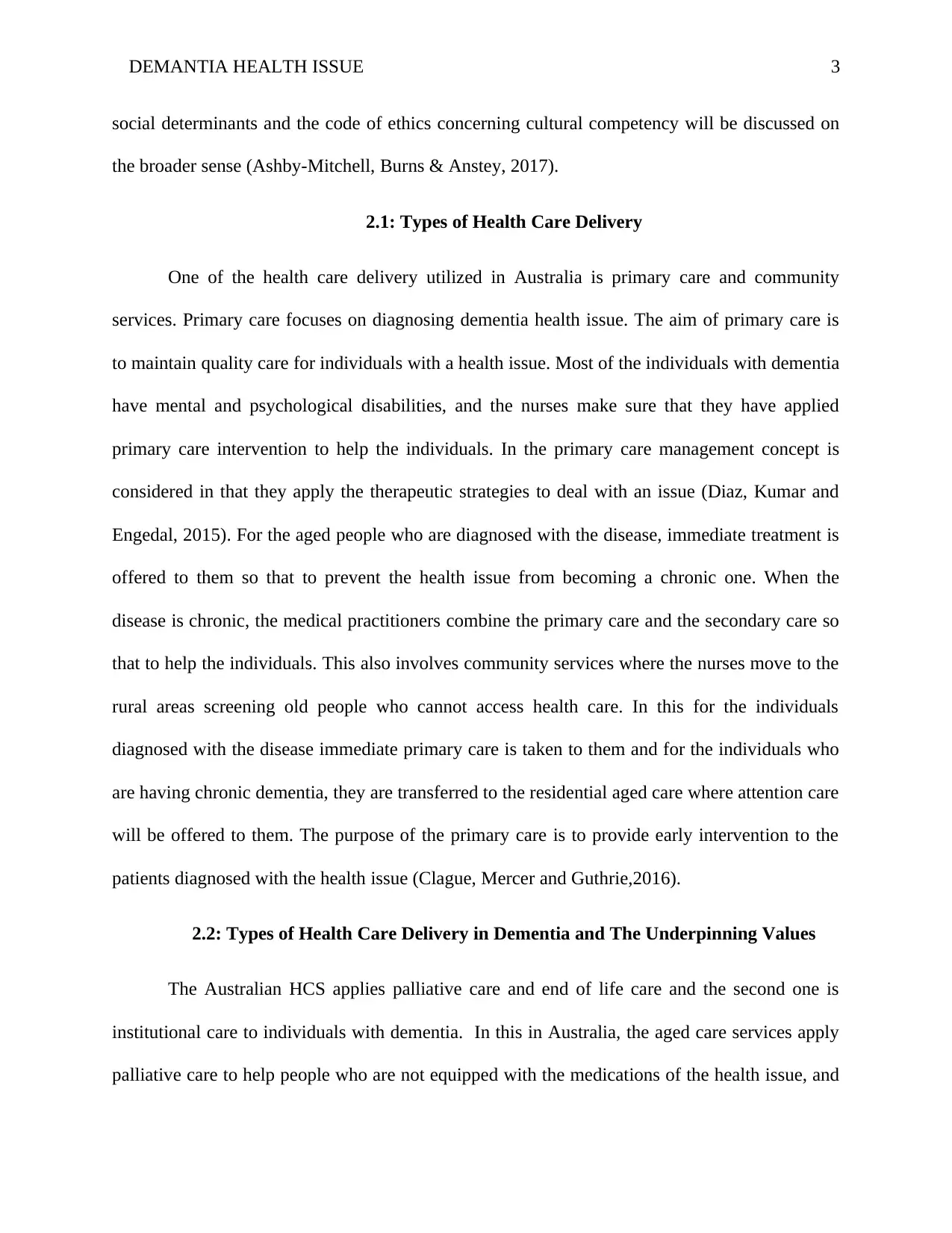
DEMANTIA HEALTH ISSUE 3
social determinants and the code of ethics concerning cultural competency will be discussed on
the broader sense (Ashby-Mitchell, Burns & Anstey, 2017).
2.1: Types of Health Care Delivery
One of the health care delivery utilized in Australia is primary care and community
services. Primary care focuses on diagnosing dementia health issue. The aim of primary care is
to maintain quality care for individuals with a health issue. Most of the individuals with dementia
have mental and psychological disabilities, and the nurses make sure that they have applied
primary care intervention to help the individuals. In the primary care management concept is
considered in that they apply the therapeutic strategies to deal with an issue (Diaz, Kumar and
Engedal, 2015). For the aged people who are diagnosed with the disease, immediate treatment is
offered to them so that to prevent the health issue from becoming a chronic one. When the
disease is chronic, the medical practitioners combine the primary care and the secondary care so
that to help the individuals. This also involves community services where the nurses move to the
rural areas screening old people who cannot access health care. In this for the individuals
diagnosed with the disease immediate primary care is taken to them and for the individuals who
are having chronic dementia, they are transferred to the residential aged care where attention care
will be offered to them. The purpose of the primary care is to provide early intervention to the
patients diagnosed with the health issue (Clague, Mercer and Guthrie,2016).
2.2: Types of Health Care Delivery in Dementia and The Underpinning Values
The Australian HCS applies palliative care and end of life care and the second one is
institutional care to individuals with dementia. In this in Australia, the aged care services apply
palliative care to help people who are not equipped with the medications of the health issue, and
social determinants and the code of ethics concerning cultural competency will be discussed on
the broader sense (Ashby-Mitchell, Burns & Anstey, 2017).
2.1: Types of Health Care Delivery
One of the health care delivery utilized in Australia is primary care and community
services. Primary care focuses on diagnosing dementia health issue. The aim of primary care is
to maintain quality care for individuals with a health issue. Most of the individuals with dementia
have mental and psychological disabilities, and the nurses make sure that they have applied
primary care intervention to help the individuals. In the primary care management concept is
considered in that they apply the therapeutic strategies to deal with an issue (Diaz, Kumar and
Engedal, 2015). For the aged people who are diagnosed with the disease, immediate treatment is
offered to them so that to prevent the health issue from becoming a chronic one. When the
disease is chronic, the medical practitioners combine the primary care and the secondary care so
that to help the individuals. This also involves community services where the nurses move to the
rural areas screening old people who cannot access health care. In this for the individuals
diagnosed with the disease immediate primary care is taken to them and for the individuals who
are having chronic dementia, they are transferred to the residential aged care where attention care
will be offered to them. The purpose of the primary care is to provide early intervention to the
patients diagnosed with the health issue (Clague, Mercer and Guthrie,2016).
2.2: Types of Health Care Delivery in Dementia and The Underpinning Values
The Australian HCS applies palliative care and end of life care and the second one is
institutional care to individuals with dementia. In this in Australia, the aged care services apply
palliative care to help people who are not equipped with the medications of the health issue, and
⊘ This is a preview!⊘
Do you want full access?
Subscribe today to unlock all pages.

Trusted by 1+ million students worldwide
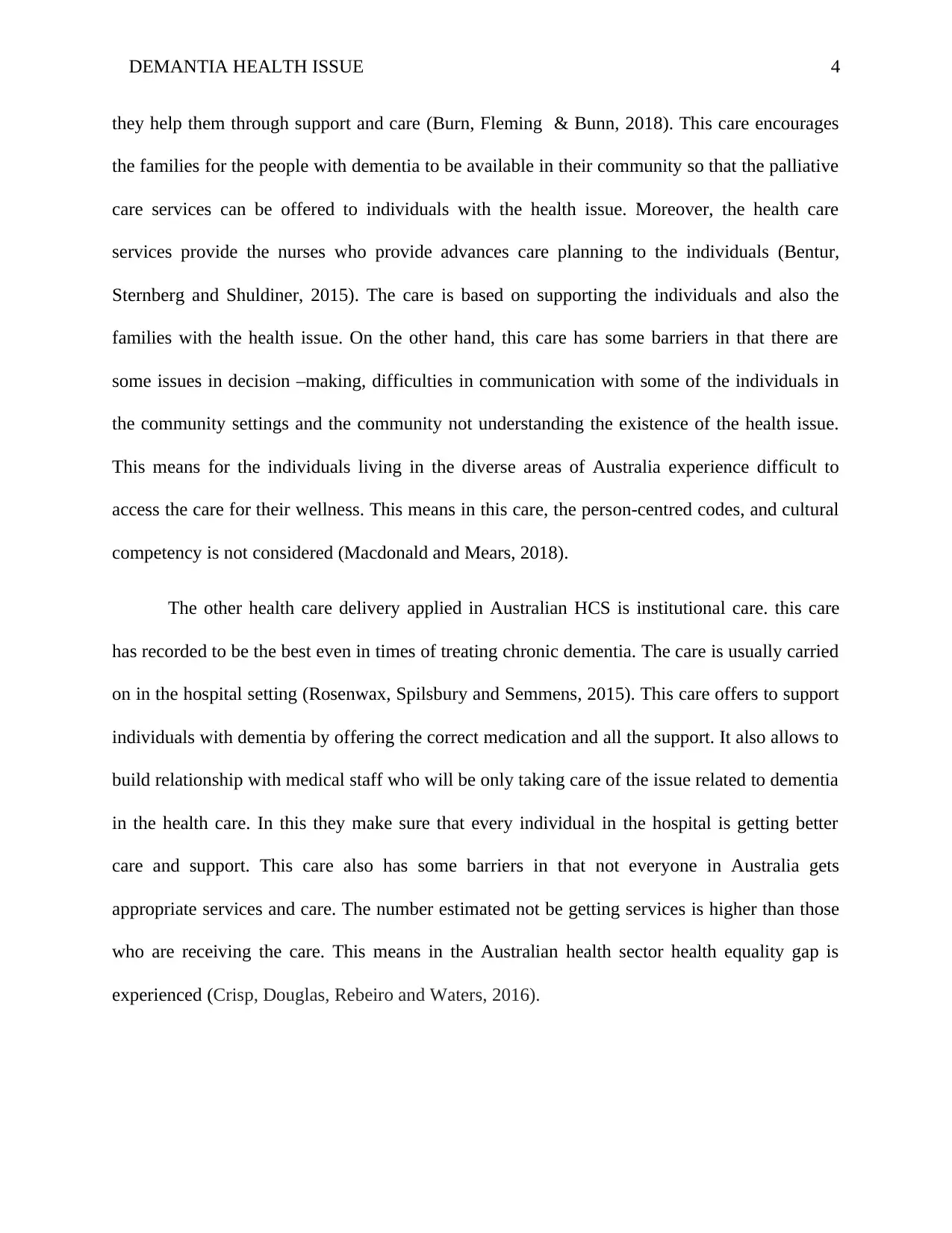
DEMANTIA HEALTH ISSUE 4
they help them through support and care (Burn, Fleming & Bunn, 2018). This care encourages
the families for the people with dementia to be available in their community so that the palliative
care services can be offered to individuals with the health issue. Moreover, the health care
services provide the nurses who provide advances care planning to the individuals (Bentur,
Sternberg and Shuldiner, 2015). The care is based on supporting the individuals and also the
families with the health issue. On the other hand, this care has some barriers in that there are
some issues in decision –making, difficulties in communication with some of the individuals in
the community settings and the community not understanding the existence of the health issue.
This means for the individuals living in the diverse areas of Australia experience difficult to
access the care for their wellness. This means in this care, the person-centred codes, and cultural
competency is not considered (Macdonald and Mears, 2018).
The other health care delivery applied in Australian HCS is institutional care. this care
has recorded to be the best even in times of treating chronic dementia. The care is usually carried
on in the hospital setting (Rosenwax, Spilsbury and Semmens, 2015). This care offers to support
individuals with dementia by offering the correct medication and all the support. It also allows to
build relationship with medical staff who will be only taking care of the issue related to dementia
in the health care. In this they make sure that every individual in the hospital is getting better
care and support. This care also has some barriers in that not everyone in Australia gets
appropriate services and care. The number estimated not be getting services is higher than those
who are receiving the care. This means in the Australian health sector health equality gap is
experienced (Crisp, Douglas, Rebeiro and Waters, 2016).
they help them through support and care (Burn, Fleming & Bunn, 2018). This care encourages
the families for the people with dementia to be available in their community so that the palliative
care services can be offered to individuals with the health issue. Moreover, the health care
services provide the nurses who provide advances care planning to the individuals (Bentur,
Sternberg and Shuldiner, 2015). The care is based on supporting the individuals and also the
families with the health issue. On the other hand, this care has some barriers in that there are
some issues in decision –making, difficulties in communication with some of the individuals in
the community settings and the community not understanding the existence of the health issue.
This means for the individuals living in the diverse areas of Australia experience difficult to
access the care for their wellness. This means in this care, the person-centred codes, and cultural
competency is not considered (Macdonald and Mears, 2018).
The other health care delivery applied in Australian HCS is institutional care. this care
has recorded to be the best even in times of treating chronic dementia. The care is usually carried
on in the hospital setting (Rosenwax, Spilsbury and Semmens, 2015). This care offers to support
individuals with dementia by offering the correct medication and all the support. It also allows to
build relationship with medical staff who will be only taking care of the issue related to dementia
in the health care. In this they make sure that every individual in the hospital is getting better
care and support. This care also has some barriers in that not everyone in Australia gets
appropriate services and care. The number estimated not be getting services is higher than those
who are receiving the care. This means in the Australian health sector health equality gap is
experienced (Crisp, Douglas, Rebeiro and Waters, 2016).
Paraphrase This Document
Need a fresh take? Get an instant paraphrase of this document with our AI Paraphraser
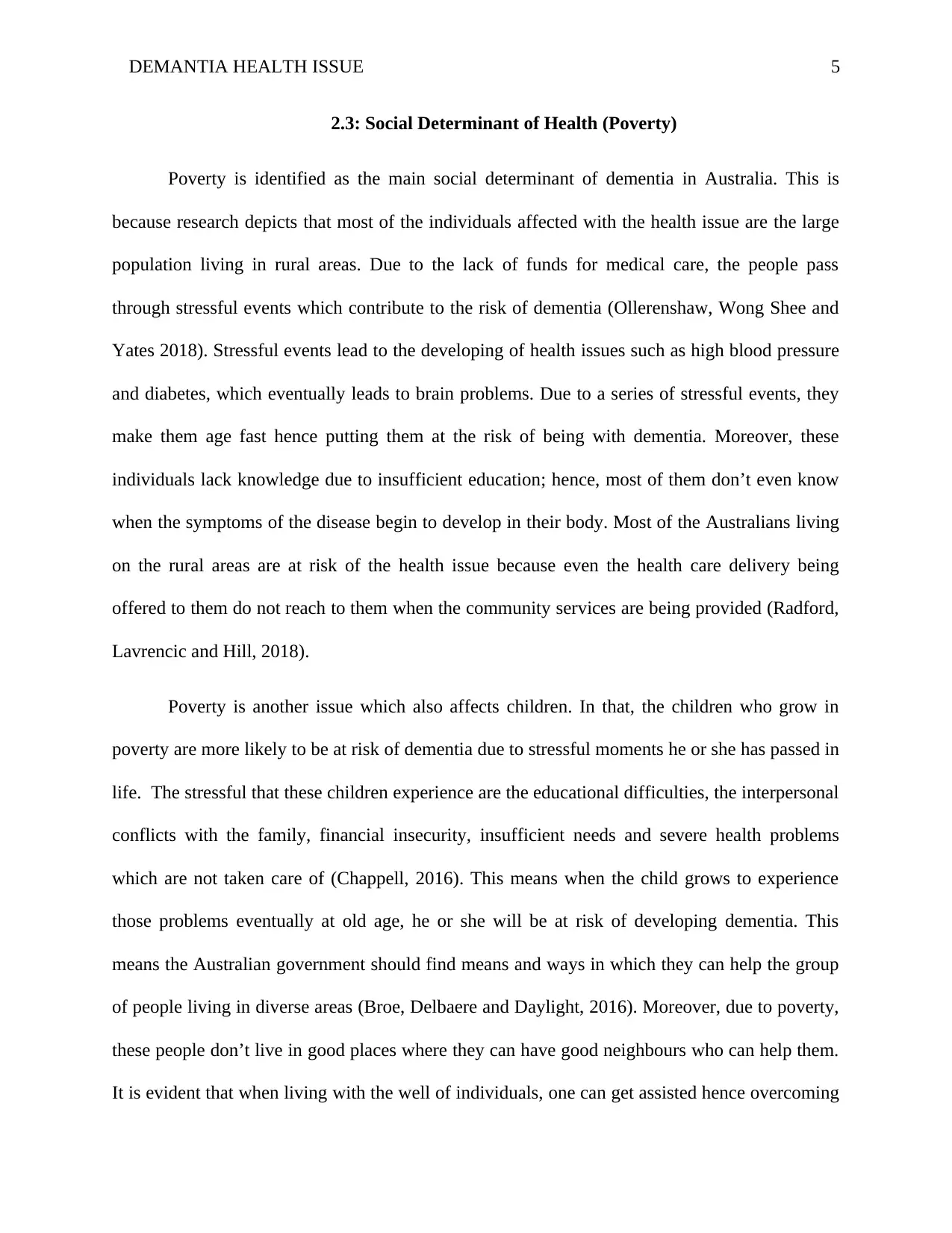
DEMANTIA HEALTH ISSUE 5
2.3: Social Determinant of Health (Poverty)
Poverty is identified as the main social determinant of dementia in Australia. This is
because research depicts that most of the individuals affected with the health issue are the large
population living in rural areas. Due to the lack of funds for medical care, the people pass
through stressful events which contribute to the risk of dementia (Ollerenshaw, Wong Shee and
Yates 2018). Stressful events lead to the developing of health issues such as high blood pressure
and diabetes, which eventually leads to brain problems. Due to a series of stressful events, they
make them age fast hence putting them at the risk of being with dementia. Moreover, these
individuals lack knowledge due to insufficient education; hence, most of them don’t even know
when the symptoms of the disease begin to develop in their body. Most of the Australians living
on the rural areas are at risk of the health issue because even the health care delivery being
offered to them do not reach to them when the community services are being provided (Radford,
Lavrencic and Hill, 2018).
Poverty is another issue which also affects children. In that, the children who grow in
poverty are more likely to be at risk of dementia due to stressful moments he or she has passed in
life. The stressful that these children experience are the educational difficulties, the interpersonal
conflicts with the family, financial insecurity, insufficient needs and severe health problems
which are not taken care of (Chappell, 2016). This means when the child grows to experience
those problems eventually at old age, he or she will be at risk of developing dementia. This
means the Australian government should find means and ways in which they can help the group
of people living in diverse areas (Broe, Delbaere and Daylight, 2016). Moreover, due to poverty,
these people don’t live in good places where they can have good neighbours who can help them.
It is evident that when living with the well of individuals, one can get assisted hence overcoming
2.3: Social Determinant of Health (Poverty)
Poverty is identified as the main social determinant of dementia in Australia. This is
because research depicts that most of the individuals affected with the health issue are the large
population living in rural areas. Due to the lack of funds for medical care, the people pass
through stressful events which contribute to the risk of dementia (Ollerenshaw, Wong Shee and
Yates 2018). Stressful events lead to the developing of health issues such as high blood pressure
and diabetes, which eventually leads to brain problems. Due to a series of stressful events, they
make them age fast hence putting them at the risk of being with dementia. Moreover, these
individuals lack knowledge due to insufficient education; hence, most of them don’t even know
when the symptoms of the disease begin to develop in their body. Most of the Australians living
on the rural areas are at risk of the health issue because even the health care delivery being
offered to them do not reach to them when the community services are being provided (Radford,
Lavrencic and Hill, 2018).
Poverty is another issue which also affects children. In that, the children who grow in
poverty are more likely to be at risk of dementia due to stressful moments he or she has passed in
life. The stressful that these children experience are the educational difficulties, the interpersonal
conflicts with the family, financial insecurity, insufficient needs and severe health problems
which are not taken care of (Chappell, 2016). This means when the child grows to experience
those problems eventually at old age, he or she will be at risk of developing dementia. This
means the Australian government should find means and ways in which they can help the group
of people living in diverse areas (Broe, Delbaere and Daylight, 2016). Moreover, due to poverty,
these people don’t live in good places where they can have good neighbours who can help them.
It is evident that when living with the well of individuals, one can get assisted hence overcoming
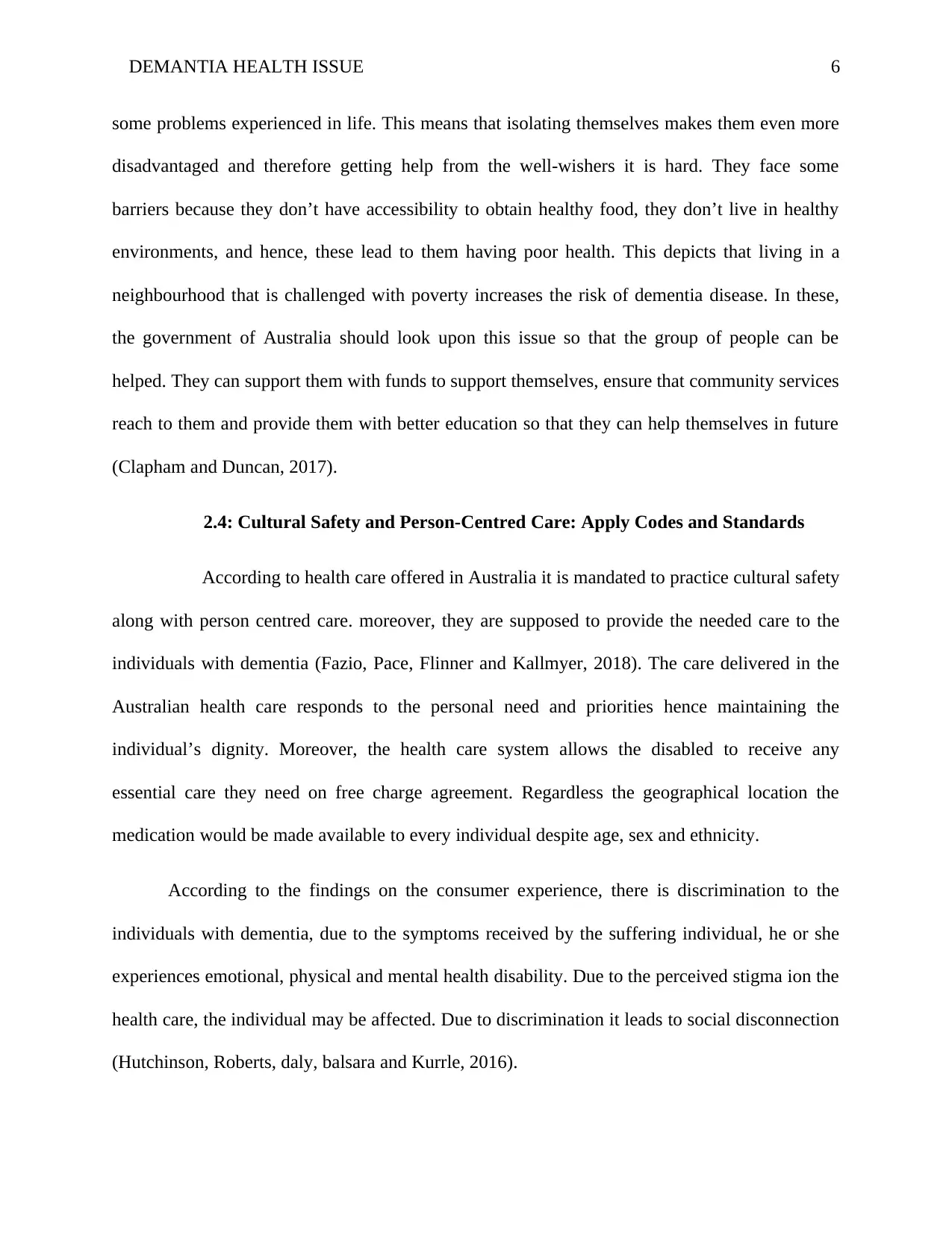
DEMANTIA HEALTH ISSUE 6
some problems experienced in life. This means that isolating themselves makes them even more
disadvantaged and therefore getting help from the well-wishers it is hard. They face some
barriers because they don’t have accessibility to obtain healthy food, they don’t live in healthy
environments, and hence, these lead to them having poor health. This depicts that living in a
neighbourhood that is challenged with poverty increases the risk of dementia disease. In these,
the government of Australia should look upon this issue so that the group of people can be
helped. They can support them with funds to support themselves, ensure that community services
reach to them and provide them with better education so that they can help themselves in future
(Clapham and Duncan, 2017).
2.4: Cultural Safety and Person-Centred Care: Apply Codes and Standards
According to health care offered in Australia it is mandated to practice cultural safety
along with person centred care. moreover, they are supposed to provide the needed care to the
individuals with dementia (Fazio, Pace, Flinner and Kallmyer, 2018). The care delivered in the
Australian health care responds to the personal need and priorities hence maintaining the
individual’s dignity. Moreover, the health care system allows the disabled to receive any
essential care they need on free charge agreement. Regardless the geographical location the
medication would be made available to every individual despite age, sex and ethnicity.
According to the findings on the consumer experience, there is discrimination to the
individuals with dementia, due to the symptoms received by the suffering individual, he or she
experiences emotional, physical and mental health disability. Due to the perceived stigma ion the
health care, the individual may be affected. Due to discrimination it leads to social disconnection
(Hutchinson, Roberts, daly, balsara and Kurrle, 2016).
some problems experienced in life. This means that isolating themselves makes them even more
disadvantaged and therefore getting help from the well-wishers it is hard. They face some
barriers because they don’t have accessibility to obtain healthy food, they don’t live in healthy
environments, and hence, these lead to them having poor health. This depicts that living in a
neighbourhood that is challenged with poverty increases the risk of dementia disease. In these,
the government of Australia should look upon this issue so that the group of people can be
helped. They can support them with funds to support themselves, ensure that community services
reach to them and provide them with better education so that they can help themselves in future
(Clapham and Duncan, 2017).
2.4: Cultural Safety and Person-Centred Care: Apply Codes and Standards
According to health care offered in Australia it is mandated to practice cultural safety
along with person centred care. moreover, they are supposed to provide the needed care to the
individuals with dementia (Fazio, Pace, Flinner and Kallmyer, 2018). The care delivered in the
Australian health care responds to the personal need and priorities hence maintaining the
individual’s dignity. Moreover, the health care system allows the disabled to receive any
essential care they need on free charge agreement. Regardless the geographical location the
medication would be made available to every individual despite age, sex and ethnicity.
According to the findings on the consumer experience, there is discrimination to the
individuals with dementia, due to the symptoms received by the suffering individual, he or she
experiences emotional, physical and mental health disability. Due to the perceived stigma ion the
health care, the individual may be affected. Due to discrimination it leads to social disconnection
(Hutchinson, Roberts, daly, balsara and Kurrle, 2016).
⊘ This is a preview!⊘
Do you want full access?
Subscribe today to unlock all pages.

Trusted by 1+ million students worldwide
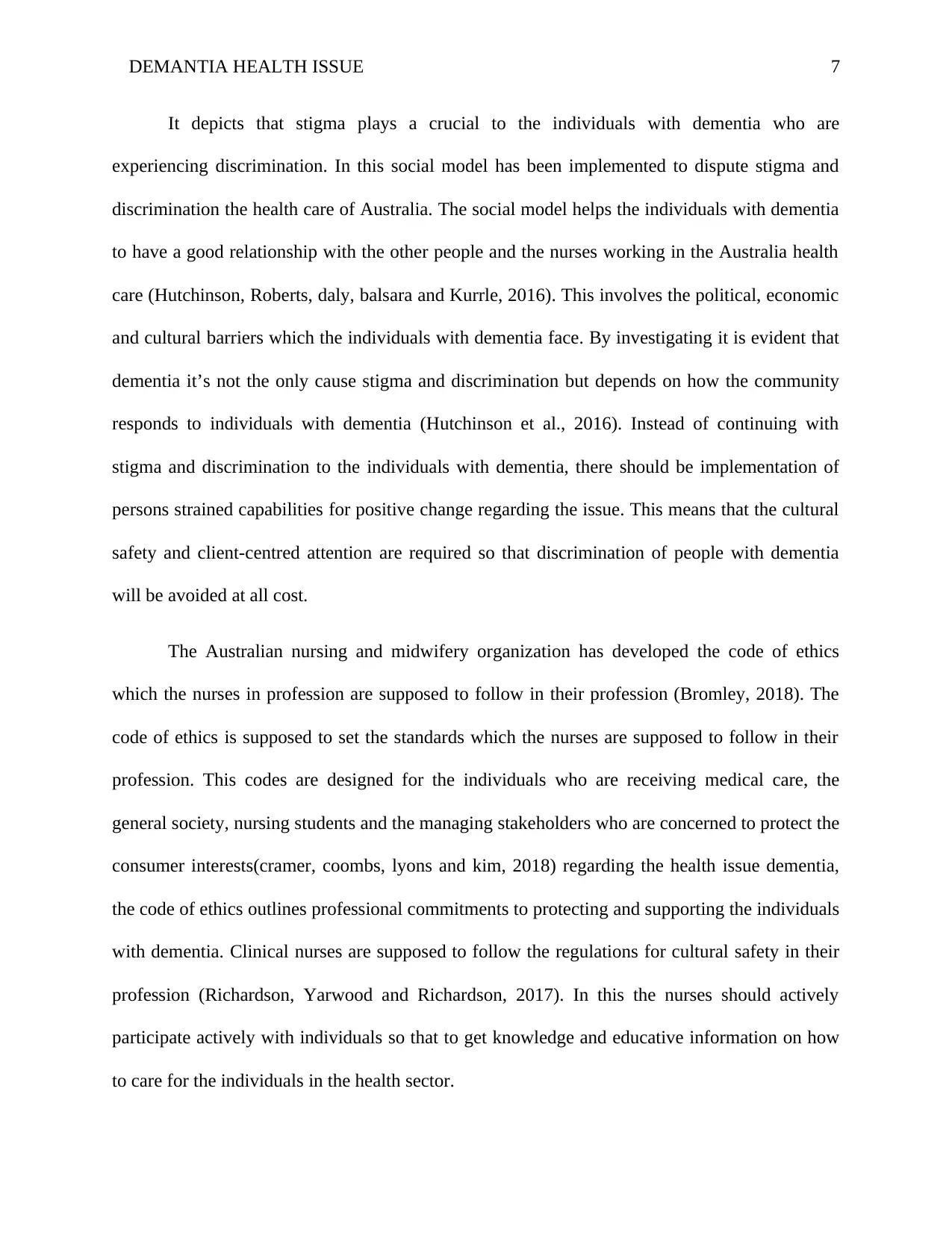
DEMANTIA HEALTH ISSUE 7
It depicts that stigma plays a crucial to the individuals with dementia who are
experiencing discrimination. In this social model has been implemented to dispute stigma and
discrimination the health care of Australia. The social model helps the individuals with dementia
to have a good relationship with the other people and the nurses working in the Australia health
care (Hutchinson, Roberts, daly, balsara and Kurrle, 2016). This involves the political, economic
and cultural barriers which the individuals with dementia face. By investigating it is evident that
dementia it’s not the only cause stigma and discrimination but depends on how the community
responds to individuals with dementia (Hutchinson et al., 2016). Instead of continuing with
stigma and discrimination to the individuals with dementia, there should be implementation of
persons strained capabilities for positive change regarding the issue. This means that the cultural
safety and client-centred attention are required so that discrimination of people with dementia
will be avoided at all cost.
The Australian nursing and midwifery organization has developed the code of ethics
which the nurses in profession are supposed to follow in their profession (Bromley, 2018). The
code of ethics is supposed to set the standards which the nurses are supposed to follow in their
profession. This codes are designed for the individuals who are receiving medical care, the
general society, nursing students and the managing stakeholders who are concerned to protect the
consumer interests(cramer, coombs, lyons and kim, 2018) regarding the health issue dementia,
the code of ethics outlines professional commitments to protecting and supporting the individuals
with dementia. Clinical nurses are supposed to follow the regulations for cultural safety in their
profession (Richardson, Yarwood and Richardson, 2017). In this the nurses should actively
participate actively with individuals so that to get knowledge and educative information on how
to care for the individuals in the health sector.
It depicts that stigma plays a crucial to the individuals with dementia who are
experiencing discrimination. In this social model has been implemented to dispute stigma and
discrimination the health care of Australia. The social model helps the individuals with dementia
to have a good relationship with the other people and the nurses working in the Australia health
care (Hutchinson, Roberts, daly, balsara and Kurrle, 2016). This involves the political, economic
and cultural barriers which the individuals with dementia face. By investigating it is evident that
dementia it’s not the only cause stigma and discrimination but depends on how the community
responds to individuals with dementia (Hutchinson et al., 2016). Instead of continuing with
stigma and discrimination to the individuals with dementia, there should be implementation of
persons strained capabilities for positive change regarding the issue. This means that the cultural
safety and client-centred attention are required so that discrimination of people with dementia
will be avoided at all cost.
The Australian nursing and midwifery organization has developed the code of ethics
which the nurses in profession are supposed to follow in their profession (Bromley, 2018). The
code of ethics is supposed to set the standards which the nurses are supposed to follow in their
profession. This codes are designed for the individuals who are receiving medical care, the
general society, nursing students and the managing stakeholders who are concerned to protect the
consumer interests(cramer, coombs, lyons and kim, 2018) regarding the health issue dementia,
the code of ethics outlines professional commitments to protecting and supporting the individuals
with dementia. Clinical nurses are supposed to follow the regulations for cultural safety in their
profession (Richardson, Yarwood and Richardson, 2017). In this the nurses should actively
participate actively with individuals so that to get knowledge and educative information on how
to care for the individuals in the health sector.
Paraphrase This Document
Need a fresh take? Get an instant paraphrase of this document with our AI Paraphraser
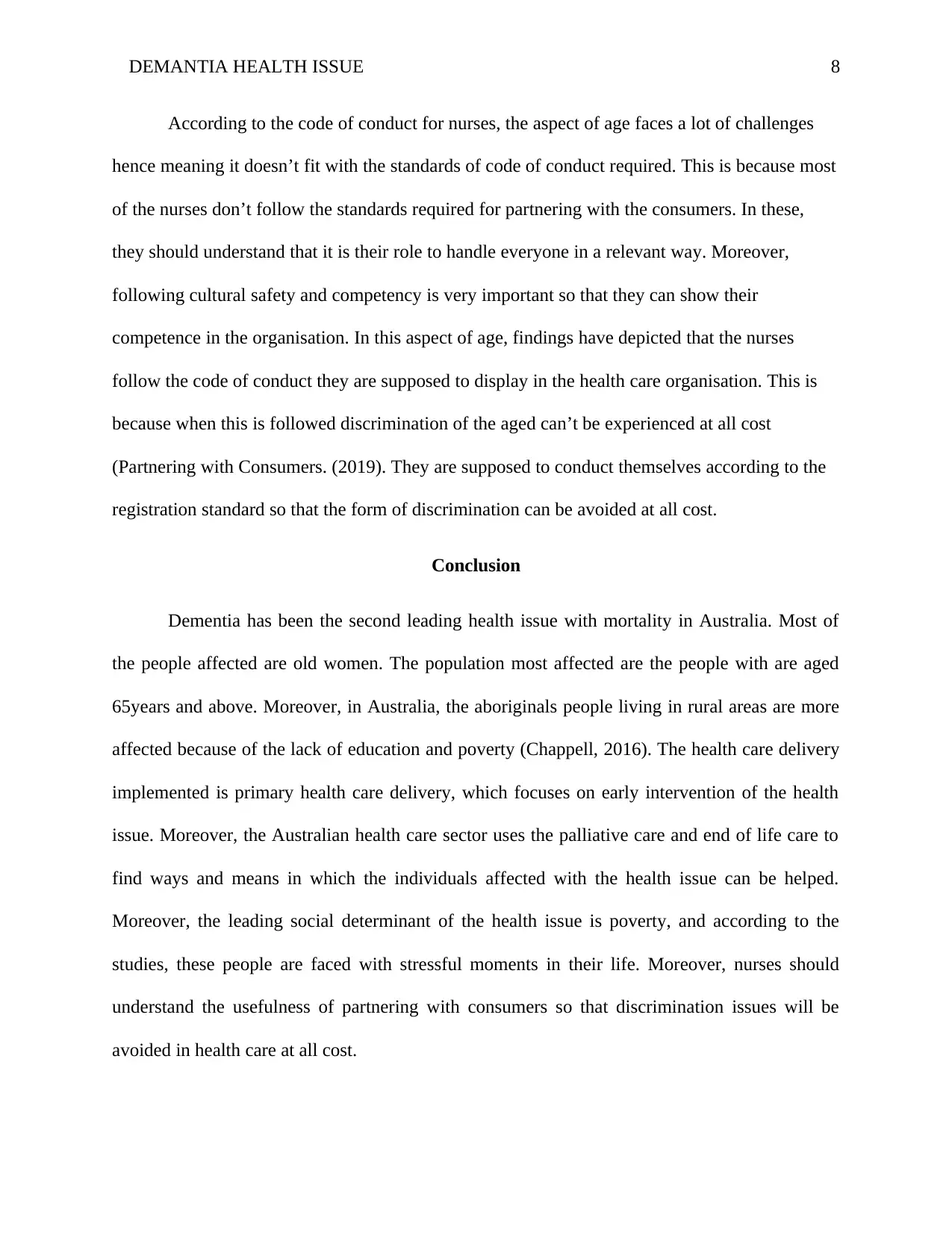
DEMANTIA HEALTH ISSUE 8
According to the code of conduct for nurses, the aspect of age faces a lot of challenges
hence meaning it doesn’t fit with the standards of code of conduct required. This is because most
of the nurses don’t follow the standards required for partnering with the consumers. In these,
they should understand that it is their role to handle everyone in a relevant way. Moreover,
following cultural safety and competency is very important so that they can show their
competence in the organisation. In this aspect of age, findings have depicted that the nurses
follow the code of conduct they are supposed to display in the health care organisation. This is
because when this is followed discrimination of the aged can’t be experienced at all cost
(Partnering with Consumers. (2019). They are supposed to conduct themselves according to the
registration standard so that the form of discrimination can be avoided at all cost.
Conclusion
Dementia has been the second leading health issue with mortality in Australia. Most of
the people affected are old women. The population most affected are the people with are aged
65years and above. Moreover, in Australia, the aboriginals people living in rural areas are more
affected because of the lack of education and poverty (Chappell, 2016). The health care delivery
implemented is primary health care delivery, which focuses on early intervention of the health
issue. Moreover, the Australian health care sector uses the palliative care and end of life care to
find ways and means in which the individuals affected with the health issue can be helped.
Moreover, the leading social determinant of the health issue is poverty, and according to the
studies, these people are faced with stressful moments in their life. Moreover, nurses should
understand the usefulness of partnering with consumers so that discrimination issues will be
avoided in health care at all cost.
According to the code of conduct for nurses, the aspect of age faces a lot of challenges
hence meaning it doesn’t fit with the standards of code of conduct required. This is because most
of the nurses don’t follow the standards required for partnering with the consumers. In these,
they should understand that it is their role to handle everyone in a relevant way. Moreover,
following cultural safety and competency is very important so that they can show their
competence in the organisation. In this aspect of age, findings have depicted that the nurses
follow the code of conduct they are supposed to display in the health care organisation. This is
because when this is followed discrimination of the aged can’t be experienced at all cost
(Partnering with Consumers. (2019). They are supposed to conduct themselves according to the
registration standard so that the form of discrimination can be avoided at all cost.
Conclusion
Dementia has been the second leading health issue with mortality in Australia. Most of
the people affected are old women. The population most affected are the people with are aged
65years and above. Moreover, in Australia, the aboriginals people living in rural areas are more
affected because of the lack of education and poverty (Chappell, 2016). The health care delivery
implemented is primary health care delivery, which focuses on early intervention of the health
issue. Moreover, the Australian health care sector uses the palliative care and end of life care to
find ways and means in which the individuals affected with the health issue can be helped.
Moreover, the leading social determinant of the health issue is poverty, and according to the
studies, these people are faced with stressful moments in their life. Moreover, nurses should
understand the usefulness of partnering with consumers so that discrimination issues will be
avoided in health care at all cost.
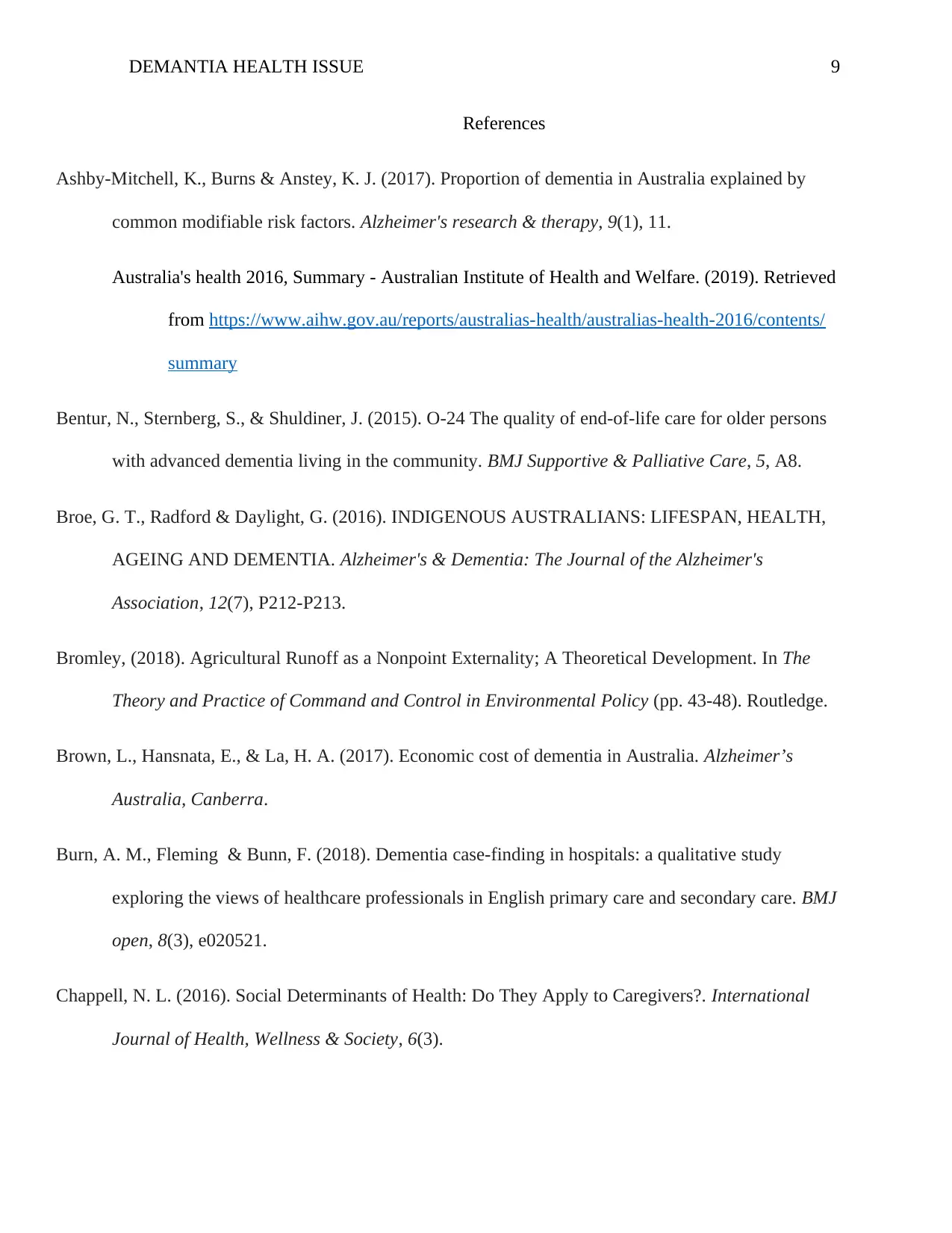
DEMANTIA HEALTH ISSUE 9
References
Ashby-Mitchell, K., Burns & Anstey, K. J. (2017). Proportion of dementia in Australia explained by
common modifiable risk factors. Alzheimer's research & therapy, 9(1), 11.
Australia's health 2016, Summary - Australian Institute of Health and Welfare. (2019). Retrieved
from https://www.aihw.gov.au/reports/australias-health/australias-health-2016/contents/
summary
Bentur, N., Sternberg, S., & Shuldiner, J. (2015). O-24 The quality of end-of-life care for older persons
with advanced dementia living in the community. BMJ Supportive & Palliative Care, 5, A8.
Broe, G. T., Radford & Daylight, G. (2016). INDIGENOUS AUSTRALIANS: LIFESPAN, HEALTH,
AGEING AND DEMENTIA. Alzheimer's & Dementia: The Journal of the Alzheimer's
Association, 12(7), P212-P213.
Bromley, (2018). Agricultural Runoff as a Nonpoint Externality; A Theoretical Development. In The
Theory and Practice of Command and Control in Environmental Policy (pp. 43-48). Routledge.
Brown, L., Hansnata, E., & La, H. A. (2017). Economic cost of dementia in Australia. Alzheimer’s
Australia, Canberra.
Burn, A. M., Fleming & Bunn, F. (2018). Dementia case-finding in hospitals: a qualitative study
exploring the views of healthcare professionals in English primary care and secondary care. BMJ
open, 8(3), e020521.
Chappell, N. L. (2016). Social Determinants of Health: Do They Apply to Caregivers?. International
Journal of Health, Wellness & Society, 6(3).
References
Ashby-Mitchell, K., Burns & Anstey, K. J. (2017). Proportion of dementia in Australia explained by
common modifiable risk factors. Alzheimer's research & therapy, 9(1), 11.
Australia's health 2016, Summary - Australian Institute of Health and Welfare. (2019). Retrieved
from https://www.aihw.gov.au/reports/australias-health/australias-health-2016/contents/
summary
Bentur, N., Sternberg, S., & Shuldiner, J. (2015). O-24 The quality of end-of-life care for older persons
with advanced dementia living in the community. BMJ Supportive & Palliative Care, 5, A8.
Broe, G. T., Radford & Daylight, G. (2016). INDIGENOUS AUSTRALIANS: LIFESPAN, HEALTH,
AGEING AND DEMENTIA. Alzheimer's & Dementia: The Journal of the Alzheimer's
Association, 12(7), P212-P213.
Bromley, (2018). Agricultural Runoff as a Nonpoint Externality; A Theoretical Development. In The
Theory and Practice of Command and Control in Environmental Policy (pp. 43-48). Routledge.
Brown, L., Hansnata, E., & La, H. A. (2017). Economic cost of dementia in Australia. Alzheimer’s
Australia, Canberra.
Burn, A. M., Fleming & Bunn, F. (2018). Dementia case-finding in hospitals: a qualitative study
exploring the views of healthcare professionals in English primary care and secondary care. BMJ
open, 8(3), e020521.
Chappell, N. L. (2016). Social Determinants of Health: Do They Apply to Caregivers?. International
Journal of Health, Wellness & Society, 6(3).
⊘ This is a preview!⊘
Do you want full access?
Subscribe today to unlock all pages.

Trusted by 1+ million students worldwide
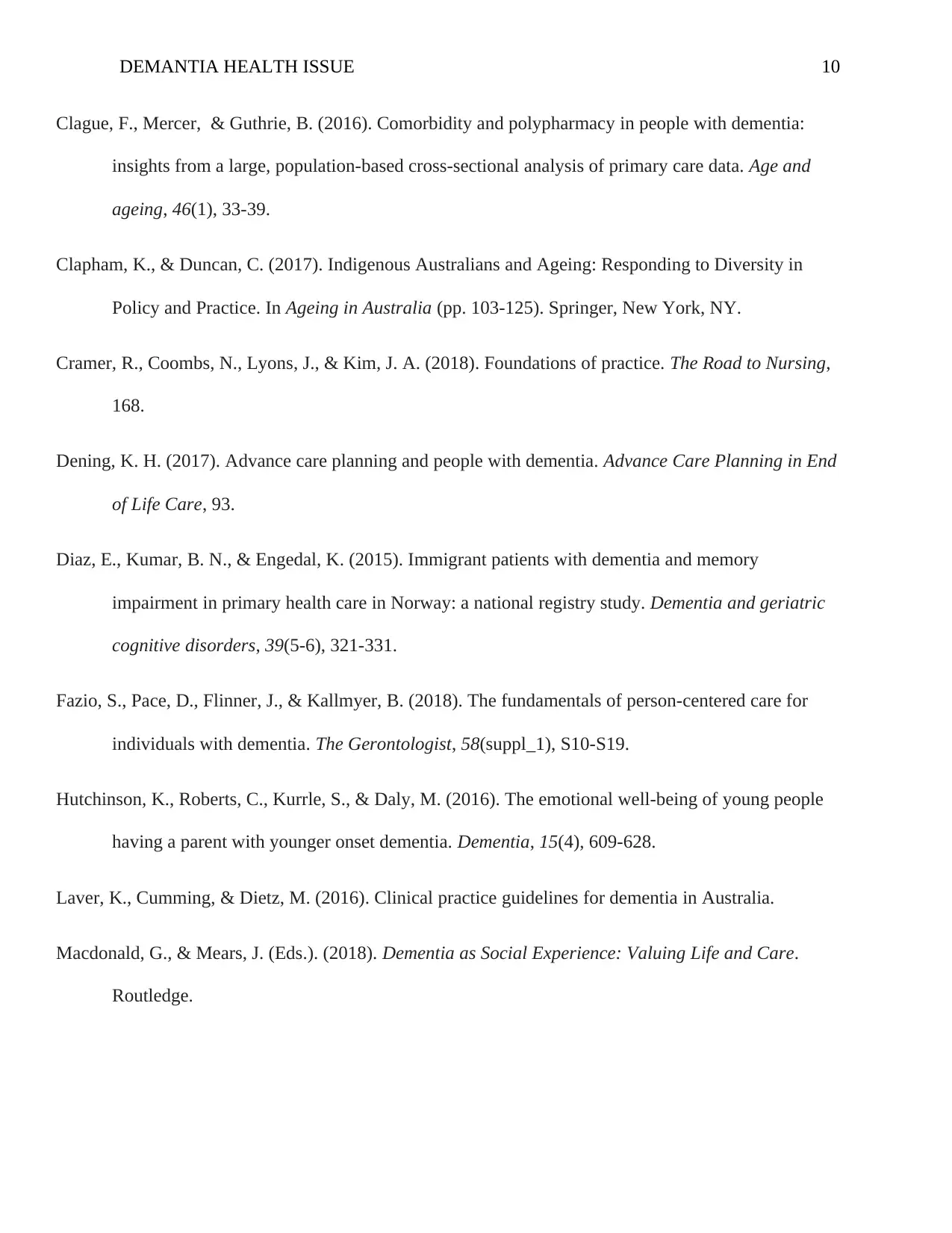
DEMANTIA HEALTH ISSUE 10
Clague, F., Mercer, & Guthrie, B. (2016). Comorbidity and polypharmacy in people with dementia:
insights from a large, population-based cross-sectional analysis of primary care data. Age and
ageing, 46(1), 33-39.
Clapham, K., & Duncan, C. (2017). Indigenous Australians and Ageing: Responding to Diversity in
Policy and Practice. In Ageing in Australia (pp. 103-125). Springer, New York, NY.
Cramer, R., Coombs, N., Lyons, J., & Kim, J. A. (2018). Foundations of practice. The Road to Nursing,
168.
Dening, K. H. (2017). Advance care planning and people with dementia. Advance Care Planning in End
of Life Care, 93.
Diaz, E., Kumar, B. N., & Engedal, K. (2015). Immigrant patients with dementia and memory
impairment in primary health care in Norway: a national registry study. Dementia and geriatric
cognitive disorders, 39(5-6), 321-331.
Fazio, S., Pace, D., Flinner, J., & Kallmyer, B. (2018). The fundamentals of person-centered care for
individuals with dementia. The Gerontologist, 58(suppl_1), S10-S19.
Hutchinson, K., Roberts, C., Kurrle, S., & Daly, M. (2016). The emotional well-being of young people
having a parent with younger onset dementia. Dementia, 15(4), 609-628.
Laver, K., Cumming, & Dietz, M. (2016). Clinical practice guidelines for dementia in Australia.
Macdonald, G., & Mears, J. (Eds.). (2018). Dementia as Social Experience: Valuing Life and Care.
Routledge.
Clague, F., Mercer, & Guthrie, B. (2016). Comorbidity and polypharmacy in people with dementia:
insights from a large, population-based cross-sectional analysis of primary care data. Age and
ageing, 46(1), 33-39.
Clapham, K., & Duncan, C. (2017). Indigenous Australians and Ageing: Responding to Diversity in
Policy and Practice. In Ageing in Australia (pp. 103-125). Springer, New York, NY.
Cramer, R., Coombs, N., Lyons, J., & Kim, J. A. (2018). Foundations of practice. The Road to Nursing,
168.
Dening, K. H. (2017). Advance care planning and people with dementia. Advance Care Planning in End
of Life Care, 93.
Diaz, E., Kumar, B. N., & Engedal, K. (2015). Immigrant patients with dementia and memory
impairment in primary health care in Norway: a national registry study. Dementia and geriatric
cognitive disorders, 39(5-6), 321-331.
Fazio, S., Pace, D., Flinner, J., & Kallmyer, B. (2018). The fundamentals of person-centered care for
individuals with dementia. The Gerontologist, 58(suppl_1), S10-S19.
Hutchinson, K., Roberts, C., Kurrle, S., & Daly, M. (2016). The emotional well-being of young people
having a parent with younger onset dementia. Dementia, 15(4), 609-628.
Laver, K., Cumming, & Dietz, M. (2016). Clinical practice guidelines for dementia in Australia.
Macdonald, G., & Mears, J. (Eds.). (2018). Dementia as Social Experience: Valuing Life and Care.
Routledge.
Paraphrase This Document
Need a fresh take? Get an instant paraphrase of this document with our AI Paraphraser
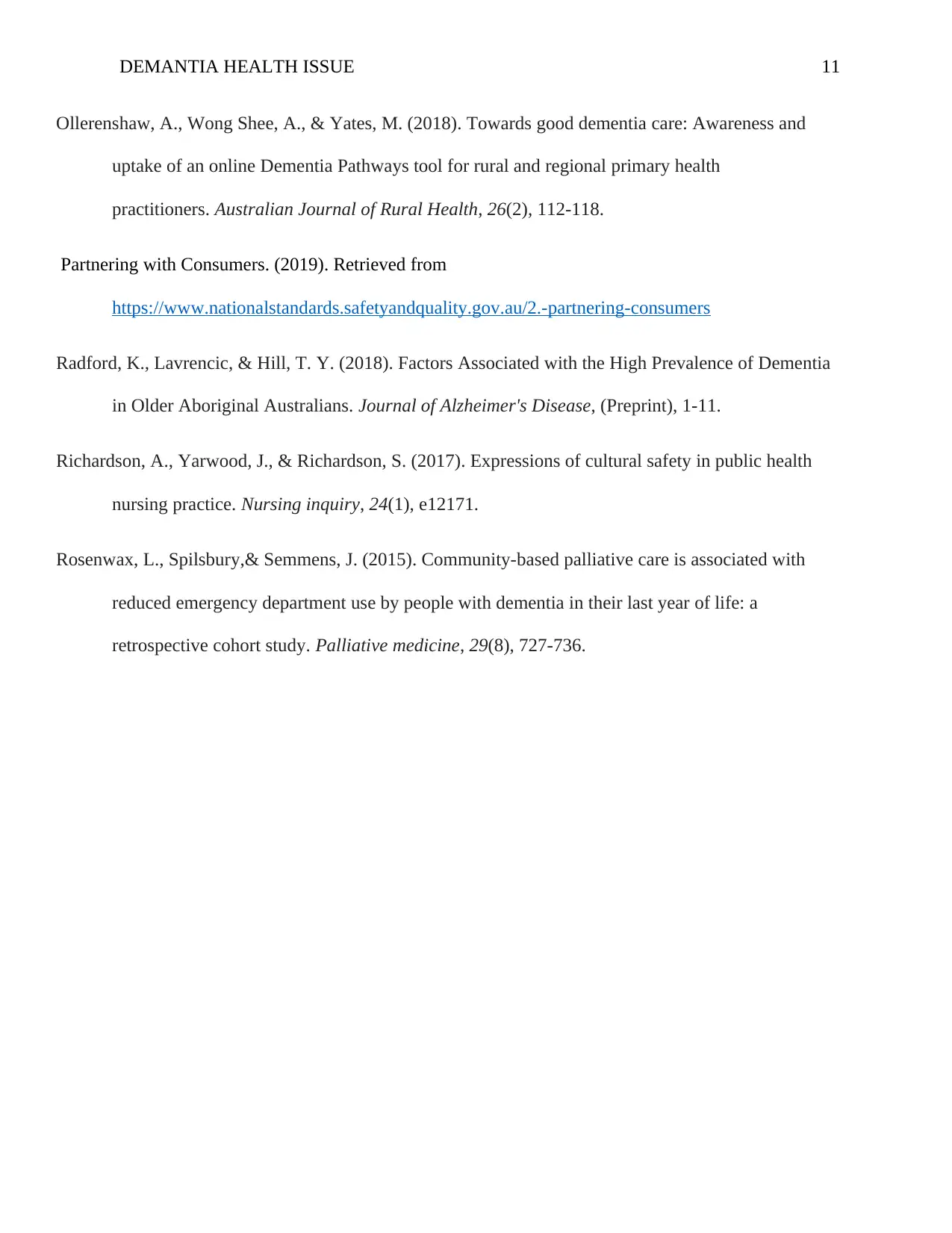
DEMANTIA HEALTH ISSUE 11
Ollerenshaw, A., Wong Shee, A., & Yates, M. (2018). Towards good dementia care: Awareness and
uptake of an online Dementia Pathways tool for rural and regional primary health
practitioners. Australian Journal of Rural Health, 26(2), 112-118.
Partnering with Consumers. (2019). Retrieved from
https://www.nationalstandards.safetyandquality.gov.au/2.-partnering-consumers
Radford, K., Lavrencic, & Hill, T. Y. (2018). Factors Associated with the High Prevalence of Dementia
in Older Aboriginal Australians. Journal of Alzheimer's Disease, (Preprint), 1-11.
Richardson, A., Yarwood, J., & Richardson, S. (2017). Expressions of cultural safety in public health
nursing practice. Nursing inquiry, 24(1), e12171.
Rosenwax, L., Spilsbury,& Semmens, J. (2015). Community-based palliative care is associated with
reduced emergency department use by people with dementia in their last year of life: a
retrospective cohort study. Palliative medicine, 29(8), 727-736.
Ollerenshaw, A., Wong Shee, A., & Yates, M. (2018). Towards good dementia care: Awareness and
uptake of an online Dementia Pathways tool for rural and regional primary health
practitioners. Australian Journal of Rural Health, 26(2), 112-118.
Partnering with Consumers. (2019). Retrieved from
https://www.nationalstandards.safetyandquality.gov.au/2.-partnering-consumers
Radford, K., Lavrencic, & Hill, T. Y. (2018). Factors Associated with the High Prevalence of Dementia
in Older Aboriginal Australians. Journal of Alzheimer's Disease, (Preprint), 1-11.
Richardson, A., Yarwood, J., & Richardson, S. (2017). Expressions of cultural safety in public health
nursing practice. Nursing inquiry, 24(1), e12171.
Rosenwax, L., Spilsbury,& Semmens, J. (2015). Community-based palliative care is associated with
reduced emergency department use by people with dementia in their last year of life: a
retrospective cohort study. Palliative medicine, 29(8), 727-736.
1 out of 11
Related Documents
Your All-in-One AI-Powered Toolkit for Academic Success.
+13062052269
info@desklib.com
Available 24*7 on WhatsApp / Email
![[object Object]](/_next/static/media/star-bottom.7253800d.svg)
Unlock your academic potential
Copyright © 2020–2025 A2Z Services. All Rights Reserved. Developed and managed by ZUCOL.





